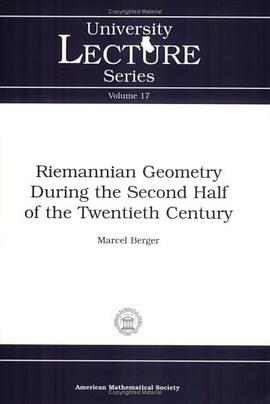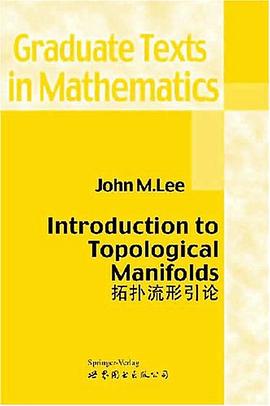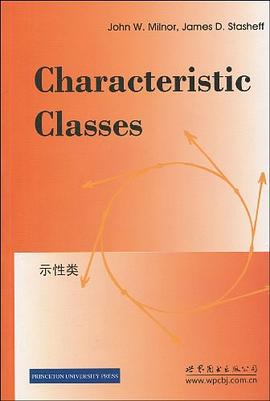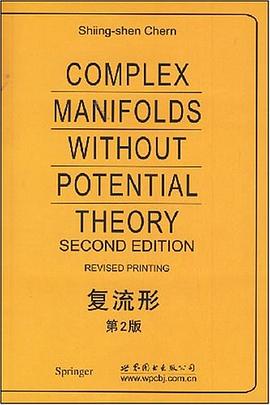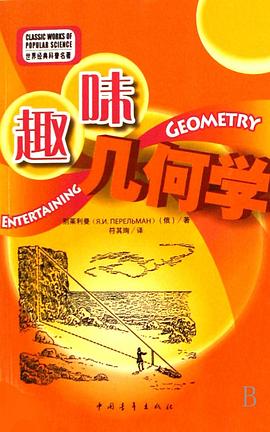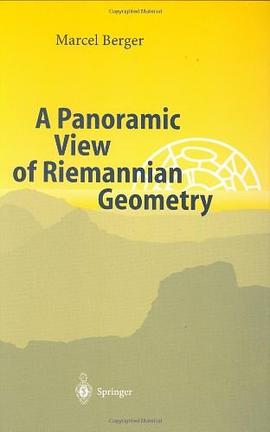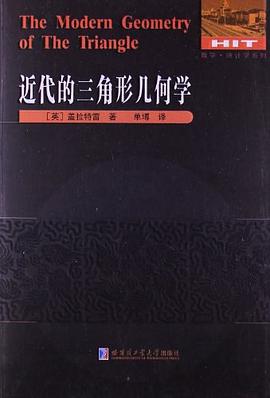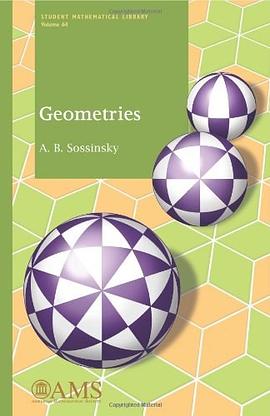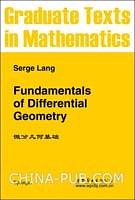《黎曼幾何概論(英文影印版)》
1 euclidean geometry
1.1 preliminaries
1.2 distance geometry
1.2.1 a basic formula
1.2.2 the length of a path
1.2.3 the first variation formula and application to billiards
1.3 plane curves
1.3.1 length
1.3.2 curvature
1.4 global theory of closed plane curves
1.4.1 "obvious" truths about curves which are hard to prove
1.4.2 the four vertex theorem
1.4.3 convexity with respect to arc length
1.4.4 umlaufsatz with corners
1.4.5 heat shrinking of plane curves
1.4.6 arnol'd's revolution in plane curve theory
1.5 the isoperimetric inequality for curves
1.6 the geometry of surfaces before and after gaul}
1.6.1 inner geometry: a first attempt
.1.6.2 looking for shortest curves: geodesics
1.6.3 the second fundamental form and principal curvatures
1.6.4 the meaning of the sign of k
1.6.5 global surface geometry
1.6.6 minimal surfaces
1.6.7 the hartman-nirenberg theorem for inner flat surfaces
1.6.8 the isoperimetric inequality in e3 a la gromov
1.6.8.1 notes
1.7 generic surfaces
1.8 heat and wave analysis in e2
1.8.1 planar physics
1.8.1.1 bibliographical note
1.8.2 why the eigenvalue problem?
1.8.3 minimax
1.8.4 shape of a drum
1.8.4.1 a few direct problems
1.8.4.2 the faber-krahn inequality
1.8.4.3 inverse problems
1.8.5 heat
1.8.5.1 eigenfunctions
1.8.6 relations between the two spectra
1.9 heat and waves in e3, ed and on the sphere
1.9.1 euclidean spaces
1.9.2 spheres
1.9.3 billiards in higher dimensions
1.9.4 the wave equation versus the heat equation
2 transition
3 surfaces from gaufi to today
3.1 gau6
3.1.1 theorema egregium
3.1.1.1 the first proof of ganβ's theorema egregium; the concept of ds2
3.1.1.2 second proof of the theorema egregium.
3.1.2 the gang-bonnet formula and the rodrigues-gauiβ map
3.1.3 parallel transport
3.1.4 inner geometry
3.2 alexandrov's theorems
3.2.1 angle corrections of legendre and gauβ in geodesy
3.3 cut loci
3.4 global surface theory
3.4.1 bending surfaces
3.4.1.1 bending polyhedra
3.4.1.2 bending and wrinkling with little smoothness
3.4.2 mean curvature rigidity of the sphere
3.4.3 negatively curved surfaces
3.4.4 the willmore conjecture
3.4.5 the global gautβ-bonnet theorem for surfaces
3.4.6 the hopf index formula
4 riemann's blueprints
4.1 smooth manifolds
4.1.1 introduction
4.1.2 the need for abstract manifolds
4.1.3 examples
4.1.3.1 submanifolds
4.1.3.2 products
4.1.3.3 lie groups
4.1.3.4 homogeneous spaces
4.1.3.5 orassmannians over various algebras
4.1.3.6 gluing
4.1.4 the classification of manifolds
4.1.4.1 surfaces
4.1.4.2 higher dimensions
4.1.4.3 embedding manifolds in euclidean space
4.2 calculus on manifolds
4.2.1 tangent spaces and the tangent bundle
4.2.2 differential forms and exterior calculus
4.3 examples of riemann's definition
4.3.1 riemann's definition
4.3.2 hyperbolic geometry
4.3.3 products, coverings and quotients
4.3.3.1 products
4.3.3.2 coverings
4.3.4 homogeneous spaces
4.3.5 symmetric spaces
4.3.5.1 classification
4.3.5.2 rank
4.3.6 riemannian submersions
4.3.7 gluing and surgery
4.3.7.1 gluing of hyperbolic surfaces
4.3.7.2 higher dimensional gluing
4.3.8 classical mechanics
4.4 the riemann curvature tensor
4.4.1 discovery and definition
4.4.2 the sectional curvature
4.4.3 standard examples
4.4.3.1 constant sectional curvature
4.4.3.2 projective spaces kpn
4.4.3.3 products
4.4.3.4 homogeneous spaces
4.4.3.5 hypersurfaces in euclidean space
4.5 a naive question: does the curvature determine the metric?
4.5.1 surfaces
4.5.2 any dimension
4.6 abstract riemannian manifolds
4.6.1 isometrically embedding surfaces in e3
4.6.2 local isometric embedding of surfaces in ms
4.6.3 isometric embedding in higher dimensions
5 a one page panorama
6 metric geometry and curvature
6.1 first metric properties
6.1.1 local properties
6.1.2 hopf-rinow and de rham theorems
6.1.2.1 products
6.1.3 convexity and small balls
6.1.4 totally geodesic submanifolds
6.1.5 center of mass
6.1.6 examples of geodesics
6.1.7 transition
6.2 first technical tools
6.3 second technical tools
6.3.1 exponential map
6.3.1.1 rank
6.3.2 space forms
6.3.3 nonpositive curvature
6.4 triangle comparison theorems
6.4.1 bounded sectional curvature
6.4.2 ricci lower bound
6.4.3 philosophy behind these bounds
6.5 injectivity, convexity radius and cut locus
6.5.1 definition of cut points and injectivity radius
6.5.2 klingenberg and cheeger theorems
6.5.3 convexity radius
6.5.4 cut locus
6.5.5 blaschke manifolds
6.6 geometric hierarchy
6.6.1 the geometric hierarchy
6.6.1.1 space forms
6.6.1.2 rank 1 symmetric spaces
6.6.1.3 measure isotropy
6.6.1.4 symmetric spaces
6.6.1.5 homogeneous spaces
6.6.2 constant sectional curvature
6.6.2.1 negatively curved space forms in three and higher dimensions
6.6.2.2 mostow rigidity
6.6.2.3 classification of arithmetic and nonarithmetic negatively curved space forms
6.6.2.4 volumes of negatively curved space forms
6.6.3 rank 1 symmetric spaces
6.6.4 higher rank symmetric spaces
6.6.4.1 superrigidity
6.6.5 homogeneous spaces
7 volumes and inequalities on volumes of cycles
7.1 curvature inequalities
7.1.1 bounds on volume elements and first applications.
7.1.1.1 the canonical measure
7.1.1.2 volumes of standard spaces
7.1.1.3 the isoperimetric inequality for spheres
7.1.1.4 sectional curvature upper bounds
7.1.1.5 ricci curvature lower bounds
7.1.2 isoperimetric profile
7.1.2.1 definition and examples
7.1.2.2 the gromov-berard-besson-gallot bound.
7.1.2.3 nonpositive curvature on noncompaet manifolds
7.2 curvature free inequalities on volumes of cycles
7.2.1 curves in surfaces
7.2.1.1 loewner, pu and blatter-bavard theorems
7.2.1.2 higher genus surfaces
7.2.1.3 the sphere
7.2.1.4 homolngical systoles
7.2.2 inequalities for curves
7.2.2.1 the problem, and standard manifolds
7.2.2.2 filling volume and filling radius
7.2.2.3 gromov's theorem and sketch of the proof
7.2.3 higher dimensional systoles:systolic freedom almost everywhere
7.2.4 embolic inequalities
7.2.4.1 introduction
7.2.4.2 the unit tangent bundle
7.2.4.3 the core of the proof
7.2.4.4 croke's three results
7.2.4.5 infinite injectivity radius
7.2.4.6 using embolic inequalities
8 transition: the next two chapters
8.1 spectral geometry and geodesic dynamics
8.2 why are riemannian manifolds so important?
8.3 positive versus negative curvature
9 spectrum of the laplacian
9.1 history
9.2 motivation
9.3 setting up
9.3.1 xdefinition
9.3.2 the hodge star
9.3.3 facts
9.3.4 heat, wave and schrodinger equations
9.4 minimax
9.4.1 the principle
9.4.2 an application
9.5 some extreme examples
9.5.1 square tori, alias several variable fourier series
9.5.2 other flat tori
9.5.3 spheres
9.5.4 kpn
9.5.5 other space forms
9.6 current questions
9.6.1 direct questions about the spectrum
9.6.2 direct problems about the eigenfunctions
9.6.3 inverse problems on the spectrum
9.7 first tools: the heat kernel and heat equation
9.7.1 the main result
9.7.2 great hopes
9.7.3 the heat kernel and ricci curvature
9.8 the wave equation: the gaps
9.9 the wave equation: spectrum & geodesic flow
9.10 the first eigenvalue
9.10.1 λ1 and ricci curvature
9.10.2 cheeger's constant
9.10.3 λ1 and volume; surfaces and multiplicity
9.10.4 kahder manifolds
9.11 results on eigenfunctions
9.11.1 distribution of the eigenfunctions
9.11.2 volume of the nodal hypersurfaces
9.11.3 distribution of the nodal hypersurfaces
9.12 inverse problems
9.12.1 the nature of the image
9.12.2 inverse problems: nonuniqueneas
9.12.3 inverse problems: finiteness, compactness
9.12.4 uniqueness and rigidity results
9.12.4.1 vigneras surfaces
9.13 special cases
9.13.1 riemann surfaces
9.13.2 space forms
9.13.2.1 scars
9.14 the spectrum of exterior differential forms
10 geodesic dynamics
10.1 introduction
10.2 some well understood examples
10.2.1 surfaces of revolution
10.2.1.1 zou surfaces
10.2.1.2 weinstein surfaces
10.2.2 ellipsoids and morse theory
10.2.3 flat and other tori: influence of the fundamental group
10.2.3.1 flat tori
10.2.3.2 manifolds which are not simply connected
10.2.3.3 tori, not flat
10.2.4 space forms
10.2.4.1 space form surfaces
10.2.4.2 higher dimensional space forms
10.3 geodesics joining two points
10.3.1 birkhoff's proof for the sphere
10.3.2 morse theory
10.3.3 discoveries of morse and serre
10.3.4 computing with entropy
10.3.5 rational homology and gromov's work
10.4 periodic geodesics
10.4.1 the difficulties
10.4.2 general results
10.4.2.1 gromoll and meyer
10.4.2.2 results for the generic ("bumpy") case.
10.4.3 surfaces
10.4.3.1 the lusternik-schnirelmann theorem
10.4.3.2 the bangert-franks-hingston results
10.5 the geodesic flow
10.5.1 review of ergodic theory of dynamical systems
10.5.1.1 ergodicity and mixing
10.5.1.2 notions of entropy
10.6 negative curvature
10.6.1 distribution of geodesics
10.6.2 distribution of periodic geodesics
10.7 nonpositive curvature
10.8 entropies on various space forms
10.8.1 liouville entropy
10.9 from osserman to lohkamp
10.10 manifolds all of whose geodesics are closed
10.10.1 definitions and caution
10.10.2 bott and samelson theorems
10.10.3 the structure on a given sa and ki~
10.11 inverse problems: conjngacy of geodesic flows
11 best metrics
11.1 introduction and a possible approach
11.1.1 an approach
11.2 purely geometric functionals
11.2.1 systolic inequalities
11.2.2 counting periodic geodesics
11.2.3 the embolic constant
11.2.4 diameter and injectivity
11.3 least curved
11.3.1 definitions
11.3.1.1 inf
· · · · · · (
收起)









